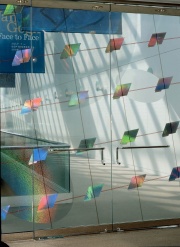Difference between revisions of "Laminated glass"
| Line 17: | Line 17: | ||
* Weather resistance (hurricanes, wind, etc.) in store fronts and windows. | * Weather resistance (hurricanes, wind, etc.) in store fronts and windows. | ||
* Sound reduction | * Sound reduction | ||
| − | + | ==Environmental Risks== | |
| + | * Laminated glass is not recyclable (as of 2024) Methods are being tried for the component separation. | ||
| + | * In Europe, laminated glass in no longer allowed in landfills | ||
| + | ==Working Properties== | ||
==Resources and Citations== | ==Resources and Citations== | ||
* Wikipedia: [https://en.wikipedia.org/wiki/Laminated_glass Laminated glass] Accessed Nov. 2024 | * Wikipedia: [https://en.wikipedia.org/wiki/Laminated_glass Laminated glass] Accessed Nov. 2024 | ||
[[Category:Materials database]][[Category:MWG]][[Category:Laminates]][[Category:Glazing]] | [[Category:Materials database]][[Category:MWG]][[Category:Laminates]][[Category:Glazing]] | ||
Revision as of 12:52, 11 November 2024
Description
Two sheets of glass with a thin layer of vinyl plastic adhered between. Laminated glass was invented in 1903 by the French chemist Édouard Bénédictus when he noticed a glass flask containing cellulose nitrate did not shatter into pieces when it broke. During World War I, laminated glass was used to strengthen the windshields of military vehicles as well as for the eyepieces in gas masks. After the war, Safety glass was adapted for use in automobile windshields and skylights. When broken, the glass fragments remain attached to the plastic rather than scattering. The interlayer is usually Polyvinyl butyral (PVB), ethylene-vinyl acetate (EVA) or thermoplastic Polyurethane (TPU). The polymer interlayer gives the glass a much higher sound insulation rating, due to the damping effect, and also blocks most of the incoming UV radiation (88-99.9%).
For additional information, see:
- Exhibit Guidelines Technical Notes: Selecting Exhibit Glazing
- Exhibit Guidelines Technical Notes: Security Glazing for Exhibit
Synonyms and Related Terms
safety glass; verre laminé (Fr.); verre calandré (Fr.); gelaagd glas (Ned.); vidro laminado (Port.)
Applications
- Architecture, glazing, automobile windows
- UV protection, skylights
- Weather resistance (hurricanes, wind, etc.) in store fronts and windows.
- Sound reduction
Environmental Risks
- Laminated glass is not recyclable (as of 2024) Methods are being tried for the component separation.
- In Europe, laminated glass in no longer allowed in landfills
Working Properties
Resources and Citations
- Wikipedia: Laminated glass Accessed Nov. 2024
